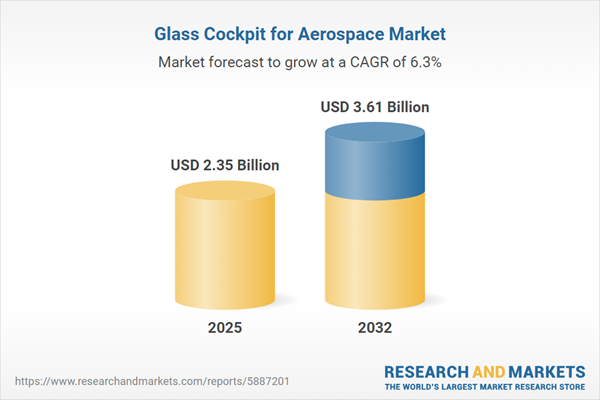Speak directly to the analyst to clarify any post sales queries you may have.
Glass cockpit technologies are transforming aviation fleet management by enabling digital integration, stronger compliance, and advanced risk management for commercial and defense operators. These digital flight solutions position aviation leaders to oversee modernization initiatives confidently, ensuring consistent control over all assets.
Market Snapshot: Glass Cockpit for Aerospace Market
The global glass cockpit for aerospace market is valued at USD 2.21 billion in 2024, with projections reaching USD 2.35 billion in 2025. By 2032, it is expected to achieve USD 3.61 billion, reflecting a compound annual growth rate of 6.31%. This targeted growth is largely driven by industry-wide replacement of legacy analog systems with integrated digital avionics. Airlines, commercial operators, and fleet managers increasingly adopt these systems to support reliability, safety, and compliance standards. Standardized digital cockpit architectures offer a unified path for upgrades, promote regulatory alignment, and facilitate digital transformation across both commercial and defense segments.
Scope & Segmentation: Key Drivers of Glass Cockpit Technology Adoption
- Platform Coverage: Glass cockpit solutions are found across a wide aircraft portfolio, serving commercial airlines, business jets, general aviation, regional carriers, and military fleets. Each segment benefits from system configurations tailored to meet specific operational scenarios and compliance frameworks.
- Component Range: The market features display types such as CRT, LCD, LED, and OLED, alongside key avionics components like flight management computers and cockpit controls. Service provisions include ongoing maintenance, technical support, dedicated crew training, and equipment upgrade options. Enhanced software tools deliver advanced diagnostics and real-time resource management for improved situational responsiveness.
- Display Types: Adoption of head-up displays, multi-function displays, and primary flight displays boosts pilot awareness and facilitates efficiency in all operational environments.
- Regional Penetration: Adoption rates differ by region. The Americas, EMEA, and Asia-Pacific exhibit distinct regulatory landscapes, digital priorities, and procurement cycles. Factors such as supply chain strength and compliance regimen updates significantly shape cockpit deployment initiatives regionally.
- Key Companies: Industry leaders include Collins Aerospace, Honeywell International, Garmin, Thales, L3Harris Technologies, BAE Systems, Elbit Systems, Universal Avionics, Avidyne, and Genesys Aerosystems. These organizations drive global standards, technological innovation, and strong supply chain connections to reinforce the progress of digital cockpit solutions.
Key Takeaways for Senior Decision-Makers
- Advanced human-machine interfaces combined with artificial intelligence features help flight crews improve in-flight decision-making and operational situational awareness.
- Implementing modular, open-architecture avionics enables organizations to streamline future cockpit upgrades and minimize transition costs.
- Rigorous documentation and support for regulatory compliance are essential for seamless digital transformation and resilient fleet management.
- Predictive maintenance and continuous crew training decrease the risk of unexpected groundings and help maximize aircraft readiness and operational reliability.
- Ongoing collaboration with key manufacturers, cybersecurity partners, and training providers is vital to bolster digital resilience and adapt to new security challenges.
- Staying current with cockpit system updates ensures alignment with regulatory changes and protects the value of avionics investments throughout their lifecycle.
Tariff Impact: Navigating Supply Chain and Procurement Challenges
Adjustments in U.S. tariff regulations are prompting aviation organizations to rethink sourcing and procurement models within the avionics ecosystem. Strategic adoption of near-shoring, expanded regional production, and supplier diversification are now common approaches for risk management. These efforts help organizations maintain agility, project stability, and continuity in both program delivery and operational cycles, despite ongoing regulatory changes affecting the global supply chain.
Methodology & Data Sources
This report utilizes a combination of independently analyzed regulatory documents, technical specifications, and direct input from manufacturing, engineering, and procurement teams. Both qualitative and quantitative data undergo comprehensive validation to provide executives with reliable, actionable insights for fleet modernization and technology investment planning.
Why This Report Matters
- Benchmarks best practices for aviation digital transformation by guiding efficient and integrated glass cockpit adoption within fleets.
- Delivers focused recommendations to reduce compliance and supply chain risks during avionics upgrades and system implementations.
- Enables decision-makers to navigate modernization confidently, balancing operational efficiency and long-term value in fleet management.
Conclusion
The integration of glass cockpit solutions empowers aviation organizations to heighten operational oversight and strengthen regulatory compliance. This report provides the strategic guidance leaders need to achieve modernization objectives and build a resilient digital foundation for future growth.
Additional Product Information:
- Purchase of this report includes 1 year online access with quarterly updates.
- This report can be updated on request. Please contact our Customer Experience team using the Ask a Question widget on our website.
Table of Contents
3. Executive Summary
4. Market Overview
7. Cumulative Impact of Artificial Intelligence 2025
Companies Mentioned
The companies profiled in this Glass Cockpit for Aerospace market report include:- Collins Aerospace, Inc.
- Honeywell International Inc.
- Garmin Ltd.
- Thales S.A.
- L3Harris Technologies, Inc.
- BAE Systems PLC
- Elbit Systems Ltd.
- Universal Avionics Systems Corporation
- Avidyne Corporation
- Genesys Aerosystems, Inc.
Table Information
| Report Attribute | Details |
|---|---|
| No. of Pages | 182 |
| Published | November 2025 |
| Forecast Period | 2025 - 2032 |
| Estimated Market Value ( USD | $ 2.35 Billion |
| Forecasted Market Value ( USD | $ 3.61 Billion |
| Compound Annual Growth Rate | 6.3% |
| Regions Covered | Global |
| No. of Companies Mentioned | 11 |









